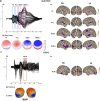Brain Source Correlates of Speech Perception and Reading Processes in Children With and Without Reading Difficulties
- PMID: 35928008
- PMCID: PMC9344064
- DOI: 10.3389/fnins.2022.921977
Brain Source Correlates of Speech Perception and Reading Processes in Children With and Without Reading Difficulties
Abstract
Neural correlates in reading and speech processing have been addressed extensively in the literature. While reading skills and speech perception have been shown to be associated with each other, their relationship remains debatable. In this study, we investigated reading skills, speech perception, reading, and their correlates with brain source activity in auditory and visual modalities. We used high-density event-related potentials (ERPs), fixation-related potentials (FRPs), and the source reconstruction method. The analysis was conducted on 12-13-year-old schoolchildren who had different reading levels. Brain ERP source indices were computed from frequently repeated Finnish speech stimuli presented in an auditory oddball paradigm. Brain FRP source indices were also computed for words within sentences presented in a reading task. The results showed significant correlations between speech ERP sources and reading scores at the P100 (P1) time range in the left hemisphere and the N250 time range in both hemispheres, and a weaker correlation for visual word processing N170 FRP source(s) in the posterior occipital areas, in the vicinity of the visual word form areas (VWFA). Furthermore, significant brain-to-brain correlations were found between the two modalities, where the speech brain sources of the P1 and N250 responses correlated with the reading N170 response. The results suggest that speech processes are linked to reading fluency and that brain activations to speech are linked to visual brain processes of reading. These results indicate that a relationship between language and reading systems is present even after several years of exposure to print.
Keywords: ERPs; FRPs; auditory N250; auditory P1; brain correlates; reading; source reconstruction; visual N170.
Copyright © 2022 Azaiez, Loberg, Hämäläinen and Leppänen.
Conflict of interest statement
The authors declare that the research was conducted in the absence of any commercial or financial relationships that could be construed as a potential conflict of interest.
Figures


Similar articles
-
Event Related Potentials to Native Speech Contrasts Predicts Word Reading Abilities in Early School-Aged Children.J Neurolinguistics. 2024 Feb;69:101161. doi: 10.1016/j.jneuroling.2023.101161. Epub 2023 Aug 24. J Neurolinguistics. 2024. PMID: 37746630 Free PMC article.
-
Brain event-related potentials to phoneme contrasts and their correlation to reading skills in school-age children.Int J Behav Dev. 2018 May;42(3):357-372. doi: 10.1177/0165025417728582. Epub 2017 Sep 18. Int J Behav Dev. 2018. PMID: 29892138 Free PMC article.
-
Tuning of the visual word processing system: distinct developmental ERP and fMRI effects.Hum Brain Mapp. 2009 Jun;30(6):1833-44. doi: 10.1002/hbm.20751. Hum Brain Mapp. 2009. PMID: 19288464 Free PMC article.
-
Infant brain responses associated with reading-related skills before school and at school age.Neurophysiol Clin. 2012 Jan-Feb;42(1-2):35-41. doi: 10.1016/j.neucli.2011.08.005. Epub 2011 Sep 17. Neurophysiol Clin. 2012. PMID: 22200340 Review.
-
Eye Movements and Fixation-Related Potentials in Reading: A Review.Vision (Basel). 2020 Feb 3;4(1):11. doi: 10.3390/vision4010011. Vision (Basel). 2020. PMID: 32028566 Free PMC article. Review.
Cited by
-
Experience-dependent effects of passive auditory exposure in infants impact theta phase synchrony and predict later language.Cereb Cortex. 2023 Jun 8;33(12):7595-7607. doi: 10.1093/cercor/bhad063. Cereb Cortex. 2023. PMID: 36967114 Free PMC article.
-
Discriminatory Brain Processes of Native and Foreign Language in Children with and without Reading Difficulties.Brain Sci. 2022 Dec 30;13(1):76. doi: 10.3390/brainsci13010076. Brain Sci. 2022. PMID: 36672057 Free PMC article.
References
LinkOut - more resources
Full Text Sources
Miscellaneous

